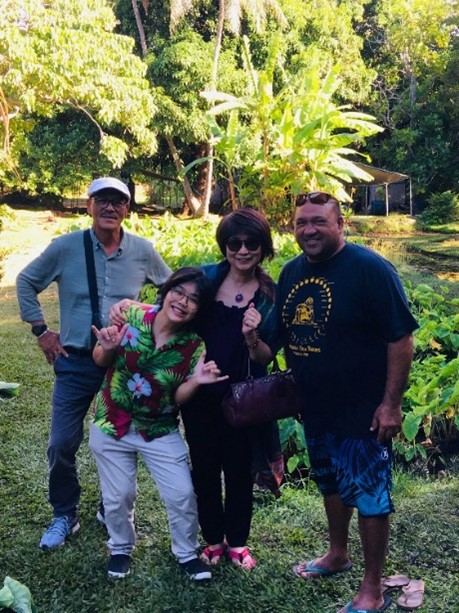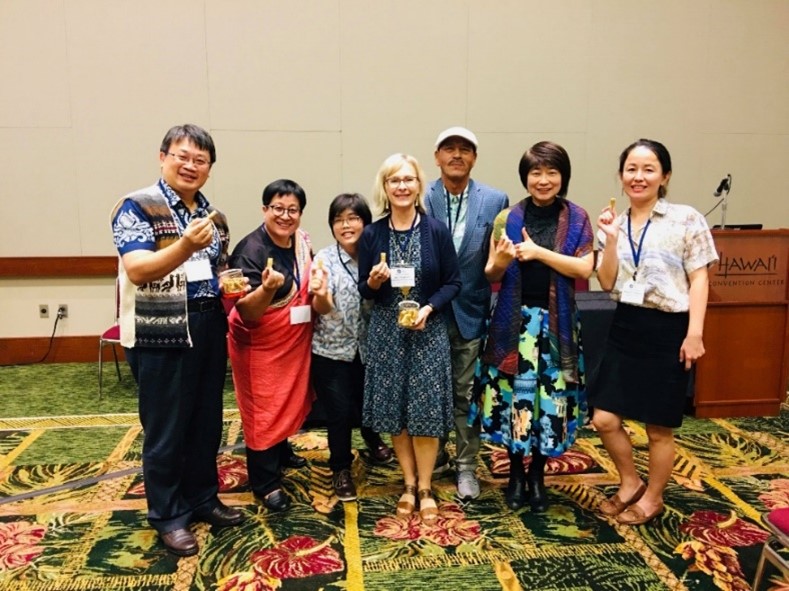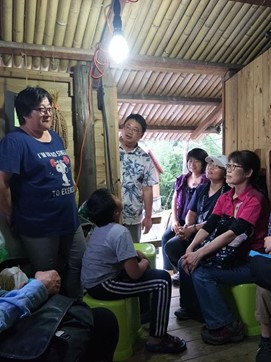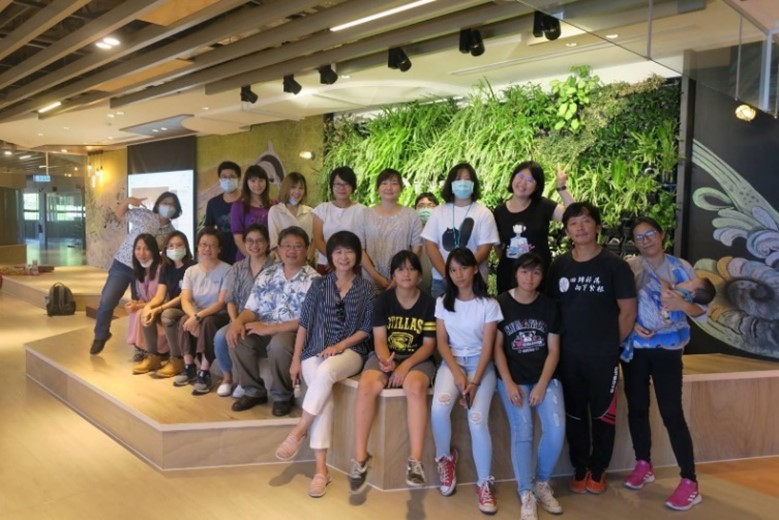Humanities and Social Sciences Approaches at the Asia-Pacific Observatory
Hsinya Huang, American and Comparative Literature, National Sun Yat-sen Univerity
Yih-ren Lin, Humanities in Medicine, Taipei Medical University
Chia-hua Lin, English Department, University of Hawai‘i at Mānoa
Ysanne Chen, International Business, National Sun Yat-sen University
The issue of food incurs ever-growing concern around the globe due to deteriorating situations such as climate change, biodiversity loss, and numerous other critical planetary challenges. In response to these crises, the Asia-Pacific Observatory joined Dr. Joni Adamson, the Director of North American Observatory, to organize a roundtable titled “Building Caring Solidarity Economies: Food Sovereignty, Community Solar, and Gastronomies of Place” and presented it at the 2019 Annual Meeting of American Studies Association (ASA). This roundtable examined communities building caring “solidarity economies” around food and energy systems. Panelists talked briefly about their work with “build as we fight” communities, then open the discussion to the audience. Yih-ren Lin and Pagung focuses on the Tayal indigenous bands in Jianshi Township, Taiwan, who have created a seed bank for traditional millet varieties. They discuss how the Tayal are preserving traditional ethnobotanical practices in their mountain communities while navigating globalization forces, including their own embrace of Christianity. Syaman Rapongan, a prominent aboriginal (Tao) writer, describes the Tao Libangbang (flying fish) culture and the sea and island ecologies of Orchid Island, Taiwan. He explains how the Tao’s traditional fishing and cooking offers people and marine life the time and space to regenerate from the impacts of nuclear contamination. Chia-hua Lin discusses her research on Ka‘ala farm, in Honolulu, where the Kanaka Maoli (Native Hawaiians) are growing traditional foods (kalo/taro) and raising fish as their kūpuna (ancestors) did. She explains how this farm is part of an Indigenous resurgence in Hawaiʻi that is pushing back against sugarcane and pineapple plantations which have caused food insecurity in Hawaii to the point that 85-90% of food must be imported. As a whole, the roundtable explores how local, community-driven movements are resisting eco-colonialism and neoliberal sustainability (green growth) while building solidarity economies or new “subsistence” perspectives based on sufficiency.
During the trip to Hawai‘i, Dr. Hsinya Huang took the opportunity and did a field study at the lo‘i kalo (taro farm) named Ka Papa Loʻi ʻo Kānewai adjacent to the campus of the University of Hawai‘i at Mānoa. Together with a well-known Tao writer, Syaman Rapongan, Dr. Huang met with the director of the lo‘i, Makahiapo Cashman, during which the director shared Hawaiian worldview regarding the caring of kalo (taro).
Precisely, Chia-Hua Lin’s project focuses on the caring of kalo in the Native Hawaiian tradition. In Kanaka Māoli (Native Hawaiian) worldview, the growing of kalo is not merely a production of food or an economic source; it is the caring of their kin. In Hawaiian myth, the firstborn son of sky father, Wākea, and earth mother, Papa, gave birth to a daughter Ho‘ohokukalani. Later Wākea and Ho‘ohokukalani had a son named Haloa-naka. The firstborn son, however, was stillborn and buried. Out of the earth where Haloa-naka was buried grew the kalo that fed the second son, also named Haloa, who became the ancestor of Kanaka Māoli. Hence, Native Hawaiians consider kalo their ancestor. Based on this worldview Kanaka Māoli developed a reciprocal relationship with and traditional knowledge about the environment. It is, therefore, not difficult to see the significance of kalo in Hawaiian culture and in the fight for environmental justice and food sovereignty in the Hawaiian context. During the visit to Ka Papa Loʻi ʻo Kānewai, we also see how students are taken to the lo‘i to learn about Hawaiian culture, traditional knowledge, and worldview by actually working in the lo‘i. Through their physical work, the bodies of the students carry and practice the ancestral memory and knowledge of Kanaka Māoli. Kumu (teacher) as well as students working in the lo‘i, Chia-Hua Lin argues, can also be considered activists asserting the food sovereignty of Kanaka Māoli.

At Ka Papa Loʻi ʻo Kānewai
(Photo credit: Chia-hua Lin)

(Photo credit: Chia-hua Lin)
Walking Workshop in the Mountainous Tayal Villages of Tian-pu, Mei-yuan, and Smangus
At the ASA Annual Meeting, the Millet Ark project Dr. Yih-Ren Lin presented with the respected Tayal practitioner and activist, Pagung Tomi, received well deserved praises for their amazing effort to preserve one of the significant crops in Tayal culture—millet. They endeavor to encourage the farmers to grow millet by creating a co-op platform on which they can sell their products to sustain not only the material life but cultural heritage surrounding the millet.
The Tayal people traditionally source food through hunting, fishing, gathering and growing crops. Qutux Niqan, “a group that eats together,” is one of the core social values of the Tayal community. Nontheless, it also helps constitute an ecological network in which this human group possess a deep awareness of the interconnective relations with nature, and thus adopts a respectful attitude towards the land in regards to collecting food. Agricultural and hunting activities are paired with rituals and ceremonies to acknowledge the spirits of the land and ask for their blessing.
Tayal hunting culture is at the root of maintaining the stainability of the landscape and ecosystem. Hunting involves knowing the prey and its place in the food chain, and requires an understanding of not only animal behavior but also plants and phenology. Furthermore, Tayal hunters set snares using only materials found on site, so as to not disturb the existing environment. Another tradition observed by the Tayal is for all members of a hunting party to make peace with one another before a hunt, in order to ensure unity when facing adversity. A hunter who passes away is believed to cross a rainbow bridge accompanied by his hound as well as his prey; further testimony that the Tayal people view the creatures they hunt as equals rather than enemies.
There are many Tayal legends cautioning against wastefulness and selfishness when it comes to food. Several tales explain that food used to be gifted freely to the tribe by the spirits and the forest. It was only once the food was squandered by lazy and greedy tribesmen did they cease to have an abundance of millet, and the Tayal people were required to grow their own crops. Thus agricultural activity of the Tayal people is strongly governed by their morals of respecting, sharing and caring for their land. The Sbalay ceremony that is performed at the start of each cultivation cycle to reinsure harmony with all the creatures that have previously used the land is yet another demonstration of the Tayal mentality.
Millet is the main crop grown by the Tayal people and is an essential part of their diet. Milestones in the cultivation process are marked by ceremonies, including those for the plowing of the fields, the sowing of the seeds, the harvesting of the crops and many more. The Tayal people also plant cucumbers around the fields as a snack for hungry workers and hunters. After harvesting and storing the crops, the Tayal people will then sun-dry and husk the millet to prepare it for culinary use. Each variety of millet can be used for a different purpose, crops that are darker in color can be distilled into liquor, stickier millet can be made into traditional Tayal variations of cakes and mochi, whereas non-sticky grains are cooked as a staple in everyday meals.
The Tayal people have a well-developed knowledge of how to ferment and marinate food for many different purposes, such as travel, rituals, feasts, or even to ward off evil spirits. Ingredients for curing meat often include onions, ginger, chili peppers, black mustard seeds, paired with hornet pupae, poultry or other game meats. Pickling containers can be pots, vats, jars, etc.; and the various processing methods include salt rubs, brine curing, dry curing, marinating, steaming, mixing and so on. An example of this is tmmyan, the famed Tayal dish of cured game meat. The meat is rubbed with salt, fermented with millet and maqaw (mountain pepper) or ginger, then stored in an airtight jar to create a delectable savory snack.
Bamboo is crucial to the Tayal lifestyle; not only is it a source of food, but it can also be made into shelter and infrastructure, tools and utensils or even clothes and instruments. The cultivation of bamboo is yet another demonstration of the Tayal’s thorough understanding of their crops; for instance, farmers know to harvest bamboo earlier in order to stimulate better growth, because interconnected roots makes trimming down older stalks beneficial to the whole bamboo grove. Elders may caution against building homes with the bamboo that produced sweeter shoots, for fear of attracting pests. Bamboo and millets are grown in turn, with newly moved-in tribes burning old bamboo groves to make way for fields of millet, then leaving behind bamboo roots again when they leave. Thus the discovery of existing groves of the dominant and resilient bamboo also indicates to future dwellers the presence of their ancestors.
Keeping with the spirit of traditional Tayal agriculture, some modern-day farmers have incorporated the use of microorganisms. The microbes are harvested from different environments through detailed observation and gathered knowledge on the plants, bacteria and fungi found in nature. The use of microorganisms in agriculture help complete the ecosystem of the farm, with the microbes aiding in the decomposition of animal waste and other organic material. For example, the addition of certain microbes to chicken coops can prevent the foul odor and pests that come with excrement, and the improved surroundings breeds healthy chickens that produce cleaner eggs. Crops are also protected with fallen leaves instead of man-made tarps as another measure to maintain the natural environment and grow plants without the use of artificial products.

(Photo credit: Shiuhhuah Serena Chou )

(Photo credit: Syax Tali)
The Humanities for Innovation and Social Practices: A Workshop on Food Futures
After the field study, Dr. Hunag invited Syax Tali, Tayal eco-farmer, teacher, and practitioner, to share his natural farming methods and philosophy.
The path of natural farming, according to Syax Tali, is a process of unlearning and relearning. He had always been a farmer, but after his wife fell ill because of the pesticide, he decided to try natural farming. As he later found out, he had to unlearn everything he thought he knew about farming and relearn everything again. Is it not also critical for us environmentalists to go through the process of unlearning and relearning when working with different communities?
Not only did he have to unlearn and relearn everything, as Syax Tali indicates, he has to constantly learn from the Mountains, the forest, and earth. The humidity, temperatures, and even the make-up and condition of microorganism change every day, even every hour. As a result, he has to observe the environment closely and learn how to care for the land and plants in different conditions. In order to develop a sustainable nature agriculture, Syax Tali also has to learn how to make natural fertilizer out of microorganisms and kitchen waste. He knows how to turn eggshell into nutrient solution for his chickens.

(Photo credit: The Humanities for Innovation and Social Practices, NSYSU)
2021 International Conference on "Food Futures," Annual Meeting of Humanities for the Environment (HfE) Network
The field trips, walking workshops, and other scholarly activities anticipate solidarity and affiliation with indigenous peoples across the Pacific. These alliances displace national perspectives in favor of a Pacific Rim perspective that connects not only regions but bio-regions, connecting local and enlarged communities and environments. In face of crises in our civilization, indigenous farmers, practitioners, activists, etc. urge us to live with care and honor and to celebrate and share the planet as a commons in ways that are more ethical and just.
All this work is currently the focus of the Observatory and undergirds the 2021 The International Conference on Food Futures, annual meeting of the Global Observatories, and a special issue of the journal Humanities, planned by Humanities for the Environmental global network of Observatories (HfE) on the topics of Environmental Humanities, Critical Food Studies, Public Health, Sustainability.
The International Conference on Food Futures is now scheduled to take place in Kaohsiung, Taiwan, headquarters of the Asia-Pacific Observatory in November 2021. The Conference invites submissions related to issues surrounding “Food in the Anthropocene.” The global food regime is a matter of growing concern within the urgent horizons of climate change and biodiversity loss, among other critical planetary challenges. The conference will ask questions about humans, food systems, and the futures of food, including but not limited to:
What role can or does culture (and the humanities, in collaboration with the social and natural sciences) play in transforming the relations between societal challenges and environmental crises where food is a central factor?
How can new/future food systems be developed that hold greater promise of sustainability than dominant local/global systems at present?
Can new consumption practices be enabled at scales that make a difference globally? If so, how?
How are humanists working in collaboration with community groups, indigenous groups, and business, to pilot public-facing projects focusing on increasing food security and sustainability?
This conference will examine the growing interconnections between food sovereignty, land and sea rights, legacies of colonization and slavery, dispossession, and food insecurities. We invite academics, writers, activists, independent scholars, and artists to submit their work.


